Chobits Discussion: Deconstructing the Harem Romance
So. Chobits. CLAMP’s first work targeting an older male audience, ripe with shots like these for the adult male’s viewing pleasure.
Before I get into it, I want to clarify that CLAMP has never been one to skimp on fan service. Only, it’s usually female fan service, with plenty of hot boys, boy-on-girl, and in particular boy-on-boy action. It’s not something they’ve been particularly subtle about, and Chobits is no different. I have no doubt that many of these ecchi shots serve little purpose than to draw in the male readers, but that’s not the point of this post.
What I really want to discuss today is how Chobits takes an incredibly cliche setup – the Harem Romance – and completely turns it on its head.
What does “harem” mean?
First off, let’s take a look at what the term “harem” means.
har•em (\ˈher-əm\) n.
- a : a usually secluded house or part of a house allotted to women in a Muslim household
b : the wives, concubines, female relatives, and servants occupying a harem - : a group of women associated with one man
- : a group of females associated with one male —used of polygamous animals
In manga, a “harem” generally refers to the second definition. Typically one male character is surrounded by many attractive female characters, at least 2 or more of whom are vying for his attention. Love Hina, The World God Only Knows, and Ichigo 100% are good examples of standard harems.
There are also reverse harems in which the standard gender roles are reversed, and instead a female is surrounded by many attractive male characters. Those tend to be more emotional and less sexual, such as Fruits Basket and Fushigi Yuugi.
Where do we see harems?
In manga and anime, as mentioned above. Harems are also incredibly common in visual novels, dating games, and adult games, in which a typical objective is to make all the right choices to ultimately “get” a girl, often culminating in adult or implied adult content once you succeed. These games are so popular, in fact, that someone actually created a troll dating game in which you date pigeons instead of boys, which surprisingly enjoyed a large degree of commercial success thanks to its satirical nature and shockingly well-written plot and backstory.
Chobits as Anti-Harem
Why do I say Chobits is anti-harem? Well, as you can see above, harem stories are often focused on getting or choosing a girl (or boy, if it’s a reverse harem), and in fact some visual novels and games will include an ultimate “harem” ending in which you get all the girls.
If we look at the ending of Chobits, however, Hideki does not get a single girl.
In fact, despite all the convenient set-ups from the beginning, it turns out that not a single girl is interested in him. You can argue that he ends up with Chii, sure, but they make it pretty clear in the manga that Chii’s feelings are ultimately not real. In chapter 86, Hideki confronts Freya, who has been living inside of Chii.
Hideki: Does that mean that Chobits… that Chii has emotions?!
Freya: No. We do not have emotions. Daddy used to call us his “Chobits,” but we are no different from other persocoms. We can’t function outside of our programming.
So Chii may have some advanced emotional simulation software built into her, but it’s ultimately just a program. On top of that, even though she looks like a cute girl, the one thing he can’t do is bang her. If Hideki were to stay faithful to Chii as he so declared, he will essentially remain a virgin for the rest of his life.
If that’s not an anti-harem ending, I don’t know what is.
Let’s look at this a bit more in detail.
The harem progression of Chobits
I didn’t mention this earlier, but a common theme amongst harems is that the girls (or guys) are all different. It’s pretty intuitive – after all, variety makes for a more interesting story. But the different “types” of characters that come up are so common that Ouran High School Host Club actually made a reverse-harem parody of it, and Chobits is no exception.
In fact, CLAMP mentioned in Clamp no Kiseki (p.11) that they intentionally tried to put in conventional characters such as an attractive female neighbor and a childhood friend, though the childhood friend never appeared. So let’s start with that.
Phase 1: Stereotypes
There’s Hibiya Chitose, the beautiful, modest landlady. There’s Shimizu Takako, a “hot” female teacher at Hideki’s cram school. Lastly, there’s Omura Yumi, the cute and energetic coworker at Hideki’s part-time job.
Of course we can’t forget the main character Chii, who conveniently appears half-naked out of nowhere right in front of Hideki’s face.
Phase 2: Getting Closer
During the first half of the manga, Hideki spends considerable time building his relationship with these women, similar to how you might in a visual novel. And to all respects, the signs seem to be positive. His landlady comes over unnaturally often, and even gives his persocom free clothes. His teacher randomly appears one evening and stays over at his apartment to drink beer with him. His coworker constantly bakes sweets to give to him and even invites him out on a date. Meanwhile, he gets to live together with an adorable persocom that somehow keeps innocently getting into naughty situations without realizing it. It’s the perfect harem setup.
I want to note here that the randomness of the situations are not uncommon as well. I once tried the beginning of Clannad, and out of the blue a girl under a tree spoke to me without turning around, after which she promptly began seeking me out in school. Straight to the point for a game? Sure. Realistic? Prooobably not.
Phase 3: Scoring It All Goes Wrong
In a typical visual novel, this is when you typically get close enough to score a chick. You’ve built up your relationship enough, and it grows into a mutual feeling of attraction (supposedly). Series like The World God Only Knows and Minamoto-kun Monogatari employ similar tactics – say all the right things, and you can win over your target’s heart.
This is not the case with Chobits. The standard harem progression pretty much screeches to a halt from here on out. What Hideki soon finds out is that all of his love interests have ulterior motives for approaching him!
- His landlady has a special connection with Chii’s past, and simply wanted to look out for her. She is loyal to her late husband.
- His teacher is having an affair with… his best friend Shimbo! She was supposed to move in with Shimbo that night but got cold feet and headed to Hideki’s at the last moment.
- His coworker has a crush on his former boss. She approached him because she overheard that he had formerly worked part-time at the same bakery she did, and thinks of him only as a brother.
- His persocom… OK, Chii might actually like him. But her emotions are programmed and she can’t ever have sex with him.
This is where CLAMP really starts to deviate, and you realize suddenly that things may not be what you thought they were, after all. And I love that they have an actual, sensible explanation for why each of the girls approached him. It’s not totally impossible, but the “senpai you seem so kind and nice that I fell in love” is way overused.
Phase 4: Social Commentary
This really happens in parallel with phase 3, but at the same time as Hideki discovers that things are not so “rosy” as he thinks, he also discovers a number of problems with his society, a number of which mirror ours.
- ISOLATION: People become so addicted to their persocoms that they stop interacting with the real world, leaving real people like Yumi and Ms. Shimizu lonely and bitter. This is a real problem. There are people out there who bake cakes for their virtual girlfriends but not the real girlfriend. Ask yourselves – is this right?
- DISPLACEMENT: This is reflected in Yumi’s worry that she can never compare to a persocom, because they can do everything better. It begs Hideki’s question – why were persocoms made to look human anyway?
- INSTANT GRATIFICATION: The answer to Hideki’s question. An increasing expectation that everything we want should be right at our fingertips coupled with an unwillingness to face the pains of personal growth would naturally give rise to persocoms. It’s the “easy way out” of loneliness. While we haven’t quite reached that point yet, instant gratification is a real problem today. Research shows that the average attention span of an adult human is now less than that of a goldfish. Eek!
- LOSS OF PURPOSE: If everyone is investing their time and energy into their persocoms, yet the persocoms will never really understand and are simply machines acting on their programming, what would be the point of that? Is it a gargantuan waste of time?
This is where we get into the real meat of Chobits, and why I love it so much. The picture book that Chii gets into, The Town with No People, also reflects these issues.
Phase 5: Questions and Answers
As Hideki goes about in search of answers to these difficult questions, he witnesses many different relationships which illustrates some important points and eventually helps him come to a resolution. These include:
Can humans love a machine?
Chobits says yes. Just look at Mr. Ueda’s love for his late wife, and the landlady’s love for her “Chobits” daughters. In fact, loving/feeling attached to a nonliving object isn’t that uncommon. Ever seen a kid crying his heart out over a broken stuffed toy? Yeah, there you go.
If it’s not uncommon, what’s the big deal?
Take a look at the Tokyo streets of Chobits. According to Hideki himself, “no one walks together anymore.” If anything, Ms. Shimizu’s story is probably the most telling – loving a nonliving object isn’t itself the problem, it’s the obsession to the point of completely neglecting real life and real people.
Can a machine love a person?
Freya says no. No matter how much it seems like love, it’s just a program and not a real emotion.
Can a machine serve as a replacement for a person?
No. Minoru discovered that no matter how close it gets, there is always the knowledge that it isn’t actually the same person.
What about Ms. Shimizu’s husband? Didn’t he basically “replace” her with a machine?
Let’s put it this way. According to Chobits, you can never truly replace one person with another because all people (including machines with learning capabilities/memories) are going to be different, and it will never be the same unique entity. So the persocom will never be an exact replica of her, but it can serve as a convenient and immersive escape, which many people are likely susceptible to.
It’s only natural – even if they aren’t alive, you are. You care because you’re alive–because you have a heart.
In that case, isn’t it bad to grow attached to a machine?
Only if you don’t have a good handle on your priorities… the same as today! 😉
Even if you have a good handle on your priorities, aren’t you just fooling yourself? They are just programs!
The ability to love and feel compassion (regardless of whether it’s returned) is a key part of what makes us human. As Ms. Hibiya’s late husband eloquently put it: “It’s only natural – even if they aren’t alive, you are. You care because you’re alive–because you have a heart.”
Did you know that the Curiosity Rover sings ‘Happy Birthday’ to itself every year on Mars, 208 million miles from home? Did that make you the tiniest bit sad? If someone said “aww” in response to that just now, would you say it was a bad thing? Of course not! It’s part of what makes us human, and what makes us beautiful. (By the way, you can send a postcard to Curiosity via the NASA website.)
Phase 6: Resolution
At this point Hideki is armed with all the answers he reached in Phase 5. But there’s one more test – their culminates in whether he is able to continue to love Chii despite her inability to have sex with him. And Hideki’s answer is great.
Hideki: I want her because I love her, not the other way around!
Now, this might seem a bit overkill within the sci-fi context. In fact, machines were invented because of their utility. And we know that small doses of escapism may actually be healthy for us. Purposely creating a machine just to see if it can be loved seems a bit trite. But taken metaphorically? I think this is a great message to project in our rape-culture filled society today.
For one, this is completely opposite to the notion of “conquering” which is prevalent not only in manga series such as The World God Only Knows or Minamoto-kun Monogatari, but also in books such as The Manual, The Game, or The Rules, which are all geared towards teaching people how to become pick-up artists. Rather than focusing on how to get what you want, the ending of Chobits is all about accepting that another person may not be able to give you what you really want… and that that’s what love is all about.
Final Remarks
I want to note here that the anime plot of Chobits differs significantly from the manga, especially in its nonsensical ending, and that the above discussion pertains to the manga only.
I also want to point out a few parts of Chobits I’m not too fond of, for example their fixation on “love” as picking out a special person and having that person pick you as a special person back. And it seems that once the “love” program kicks in, it will never change. What about one-sided love? Couldn’t the creator have built in a failsafe that lets the persocom overcome the pain of one-sided love with time and lock in on a different person, you know, like a real human would? And open relationships are quite common nowadays… though I’ll let that slide, since it was written so long ago. It does, however, bother me that all the couples are male-female, and all of the major female characters act damsels in distress that have to be “saved” by their male counterpart.
Now loading…
That said, there were a couple clever notions raised that I didn’t mention in the discussion, such as the possibility of a computer loving another computer. It wasn’t explored in too much depth, but from what I gleaned Dita and Zima’s internal “special person” recognition program kicked in and recognized each other, which Zima claimed “could be a form of love.” Who knows, but it’s a thought.
Ultimately, Chobits is a series that takes a traditional harem setup and turns it into a dialogue on morality, humanity, and loneliness. It’s not the best series in the world, but I found it thought-provoking, entertaining, and overall an enjoyable ride.

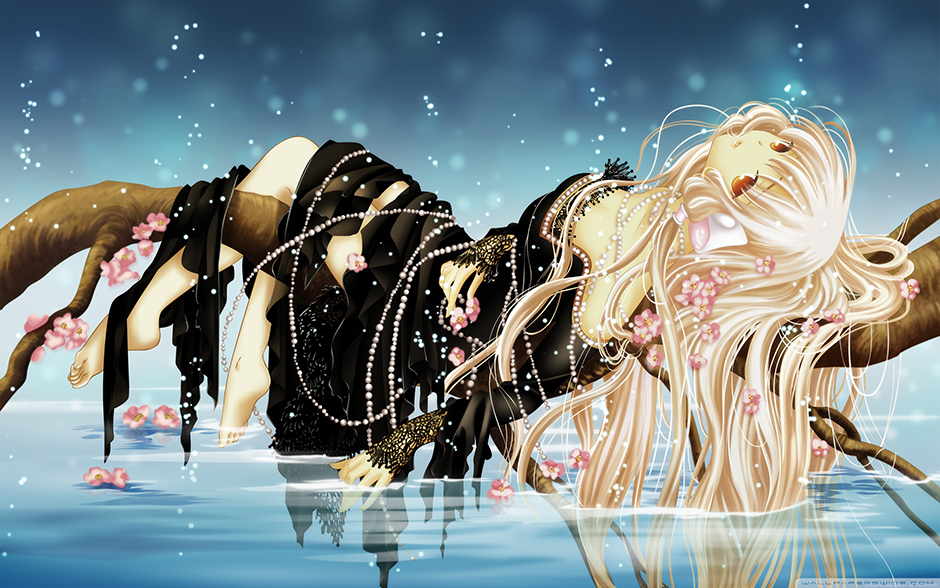
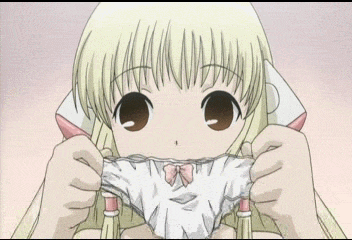
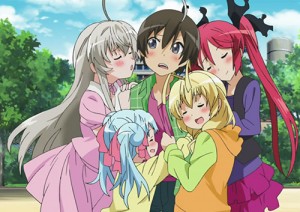

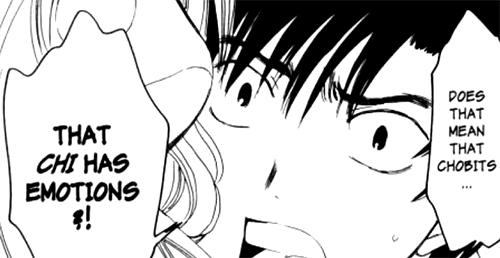
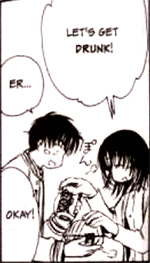
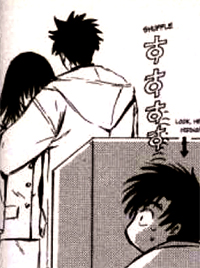
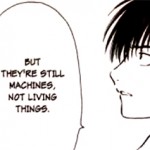

It was only recently that I came to the realization that what first appears to be one of the most tasteless and tacky love stories can also be viewed as a commentary on the visual novel genre, harem romance stories, the mythical magical girlfriend, and seinen romance as a whole.